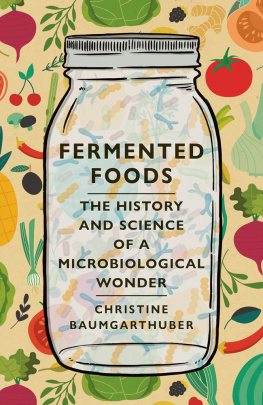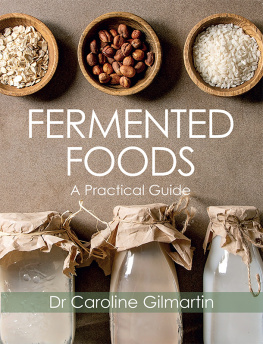Ryczek - Fermented Foods at Every Meal
Here you can read online Ryczek - Fermented Foods at Every Meal full text of the book (entire story) in english for free. Download pdf and epub, get meaning, cover and reviews about this ebook. year: 2016, publisher: Rockport Publishers;Fair Winds Press, genre: Home and family. Description of the work, (preface) as well as reviews are available. Best literature library LitArk.com created for fans of good reading and offers a wide selection of genres:
Romance novel
Science fiction
Adventure
Detective
Science
History
Home and family
Prose
Art
Politics
Computer
Non-fiction
Religion
Business
Children
Humor
Choose a favorite category and find really read worthwhile books. Enjoy immersion in the world of imagination, feel the emotions of the characters or learn something new for yourself, make an fascinating discovery.

- Book:Fermented Foods at Every Meal
- Author:
- Publisher:Rockport Publishers;Fair Winds Press
- Genre:
- Year:2016
- Rating:4 / 5
- Favourites:Add to favourites
- Your mark:
- 80
- 1
- 2
- 3
- 4
- 5
Fermented Foods at Every Meal: summary, description and annotation
We offer to read an annotation, description, summary or preface (depends on what the author of the book "Fermented Foods at Every Meal" wrote himself). If you haven't found the necessary information about the book — write in the comments, we will try to find it.
Ryczek: author's other books
Who wrote Fermented Foods at Every Meal? Find out the surname, the name of the author of the book and a list of all author's works by series.
Fermented Foods at Every Meal — read online for free the complete book (whole text) full work
Below is the text of the book, divided by pages. System saving the place of the last page read, allows you to conveniently read the book "Fermented Foods at Every Meal" online for free, without having to search again every time where you left off. Put a bookmark, and you can go to the page where you finished reading at any time.
Font size:
Interval:
Bookmark:



2016 Quarto Publishing Group USA Inc.
First published in the United States of America in 2016 by
Fair Winds Press, an imprint of
Quarto Publishing Group USA Inc.
100 Cummings Center
Suite 406-L
Beverly, Massachusetts 01915-6101
Telephone: (978) 282-9590
Fax: (978) 283-2742
QuartoKnows.com
Visit our blogs at QuartoKnows.com
All rights reserved. No part of this book may be reproduced or utilized, in any form or by any means, electronic or mechanical, without prior permission in writing from the publisher.
Digital edition published in 2016
Digital edition: 978-1-62788-851-6
Softcover edition: 978-1-59233-715-6
Library of Congress Cataloging-in-Publication Data available.
Design, cover, and page layout: Rita Sowins
Photography and cover image: Hayley Barisa Ryczek
The information in this book is for educational purposes only. It is not intended to replace the advice of a physician or medical practitioner. Please see your health-care provider before beginning any new health program.
atevery meal
Nourish Your Family at Every Meal with
QUICK AND EASY RECIPES USING THE TOP 10 LIVE-CULTURE FOODS
Hayley Barisa Ryczek


Whether or not you realize it, fermented foods are part of your everyday life. Fermentation is used in many of the foods you eat regularly, including salami, cheese, yogurt, prosciutto, and bread.
Fermentation has enjoyed a resurgence of interest in recent years, but its actually been around for millennia. Every culture in the world has a distinctive history of fermentation, such as kimchi, natto, soy sauce, and fish sauce in Asia; crock-fermented sauerkraut and fermented fish in Northern Europe; and kefir and fermented pickles in the Middle East. Throughout the years, fermentation has been used to help preserve food, keeping it edible long after it was picked or caught fresh. In many ways, fermentation provided the first convenience foods, allowing food to be stored for long periods of time without refrigeration.
But what are fermented foods? Simply put, they are foods that have healthful microbes deliberately added to modify them. Though the bacteria that cause a winters outbreak of strep throat are obviously harmful, not all bugs are bad. Bacteria can help keep us healthy in all kinds of waysfrom bolstering our immune system to digesting food.
Oftentimes, whether bacteria are good or bad is a matter of balance. For example, candida is naturally occurring bacteria found in our bodies and in small amounts is benign. However, when stress, medications, and poor diet enable it to proliferate, it can seriously damage our intestinal lining and compromise our health in all sorts of ways. When a microbial system is in balance, good microbes keep the bad microbes in line. An overgrowth of bad microbes, however, can take over and disrupt the healthy balance.
Fermentation uses the good bacteria, commonly referred to as probiotics, to make food more nutritious. The fermentation process converts the starches in foods into something thats more easily digestible. Eating fermented foods introduces the living probiotic cultured microbes into our intestinal tracts and improves digestion, allowing us to absorb more nutrients in the foods we eat. We need these good microbes to keep a healthy balance after eating a diet rich in refined sugar and white flour foods and also to fight illness.
Unfortunately, the American food industry has a phobia when it comes to bacteria. In some ways, thats a good thing. Sterilization and pasteurization have saved many lives since becoming standard practice in the middle of the twentieth century, but a growing number of people argue that its gone too far. The perceived threat of all bacteria in foods, good or bad, has led us to experience an imbalance of bacteria in our guts. This fear of bacteria is unfounded. In fact, historically people have survived because of good bacteria used to ferment foods and keep our digestive tracts healthy and running smoothly. By reintroducing traditional, fermented foods back into our diets, we can help to rebuild healthy gut bacteria.
In this book, Ill teach you all the reasons why you need to have fermented foods in your diet, how you can easily make 10 fermented foods that you and your family will love, and how to use those foods. Eating something fermented every day is a good starting point. From there, you can build up to integrating fermented foods into every meal. This can be as easy as eating yogurt with breakfast, fermented vegetables with lunch, and a fermented sauce with dinner. You can even squeeze in a refreshing glass of fizzy kombucha between meals! In these pages, you will find 100 recipes that will help you easily add fermented foods to every mealand even times in between.
In health,


Imagine living to be 100 years old. Now imagine living to be 100 while retaining your vitality. Youd be in good company in Okinawa, an archipelago 360 miles off the coast of Japan. There, according to the Okinawa Centenarian Study, youll find the worlds highest prevalence of centenarians: 740 out of a population of 1.3 million. Okinawan seniors have not only the highest life expectancy in the world, but also the highest health expectancy. They have optimal health as they age, and dont experience as much age-related disease. Perhaps not coincidentally, these seniors consume traditionally fermented foods in the forms of miso, tofu, kimchi, and soy sauce as a regular part of their diets.
The number of studies showing the health benefits of eating a diet rich in fermented foods is growing. In particular, a 2006 study done by the Japanese Society of Allergology showed that fermented foods can lessen or reduce allergies as well as plaque in the mouth, which results in fewer cavities and healthier gums. The study also showed that many people even lose weight more easily when they include fermented foods in their diets.
When you make your own fermented foods, you will derive the greatest nutritional benefits from them. Commercially fermented products such as jarred pickles are no longer full of beneficial bacteria because theyre simply cured in vinegar. The flavor, although similar, is rarely as robust as that of a traditional, homemade version. Even foods that are fermented using traditional methods can easily lose their health benefits when they are processed using pasteurization, which kills off all the beneficial bacteria that fermentation created!
Font size:
Interval:
Bookmark:
Similar books «Fermented Foods at Every Meal»
Look at similar books to Fermented Foods at Every Meal. We have selected literature similar in name and meaning in the hope of providing readers with more options to find new, interesting, not yet read works.
Discussion, reviews of the book Fermented Foods at Every Meal and just readers' own opinions. Leave your comments, write what you think about the work, its meaning or the main characters. Specify what exactly you liked and what you didn't like, and why you think so.


